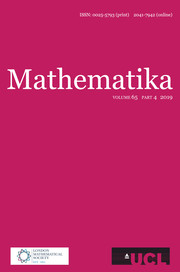Crossref Citations
This article has been cited by the following publications. This list is generated based on data provided by Crossref.
Abels, Herbert
1983.
Which groups act distally?.
Ergodic Theory and Dynamical Systems,
Vol. 3,
Issue. 2,
p.
167.
Mukhin, Yu. N.
1985.
Topological groups.
Journal of Soviet Mathematics,
Vol. 28,
Issue. 6,
p.
825.
Milnes, P.
1994.
Distal compact right topological groups.
Acta Mathematica Hungarica,
Vol. 65,
Issue. 2,
p.
149.
Dani, S. G.
and
Raja, C. R. E.
1998.
A Note on Tortrat Groups.
Journal of Theoretical Probability,
Vol. 11,
Issue. 2,
p.
571.
Baumgartner, Udo
and
Willis, George A.
2004.
Contraction groups and scales of automorphisms of totally disconnected locally compact groups.
Israel Journal of Mathematics,
Vol. 142,
Issue. 1,
p.
221.
Raja, C. R. E.
and
Shah, Riddhi
2010.
Distal actions and shifted convolution property.
Israel Journal of Mathematics,
Vol. 177,
Issue. 1,
p.
391.
RAJA, C. R. E.
and
SHAH, RIDDHI
2019.
Some properties of distal actions on locally compact groups.
Ergodic Theory and Dynamical Systems,
Vol. 39,
Issue. 5,
p.
1340.
PALIT, RAJDIP
and
SHAH, RIDDHI
2021.
DISTAL ACTIONS OF AUTOMORPHISMS OF NILPOTENT GROUPS G ON SUBG AND APPLICATIONS TO LATTICES IN LIE GROUPS.
Glasgow Mathematical Journal,
Vol. 63,
Issue. 2,
p.
343.
SHAH, RIDDHI
and
YADAV, ALOK KUMAR
2022.
Distal Actions of Automorphisms of Lie Groups G on SubG.
Mathematical Proceedings of the Cambridge Philosophical Society,
Vol. 173,
Issue. 2,
p.
457.
CHATTERJEE, DEBAMITA
and
SHAH, RIDDHI
2025.
CHARACTERISATION OF DISTAL ACTIONS OF AUTOMORPHISMS ON THE SPACE OF ONE-PARAMETER SUBGROUPS OF LIE GROUPS.
Journal of the Australian Mathematical Society,
Vol. 119,
Issue. 2,
p.
152.

